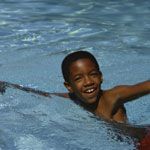
Being safe around water is important for all of us, but this is especially the case when it comes to young kids.
In Australia, more kids die from drowning than from any other cause except illness. It’s also estimated that for every child who dies, three or four survive but often suffer from permanent brain damage
Young children can drown very quickly, which means that it’s essential for kids to be supervised AT ALL TIMES when they’re around water. Toddlers from ages one to three are most at risk, as they’re old enough to move around and be curious, but don’t yet understand the dangers of water.
Young children can drown in only a few centimetres of water. It may be hard to believe, but approximately 15 per cent of child drownings happen in the bath. Other less obvious places where drowning can occur include inflatable swimming pools, nappy buckets, water tanks, backyard ponds and pet’s water bowls.
Some important ways to keep your kids safe include:
- Use a nappy bucket with a tight-fitting lid and keep the bucket closed and out of reach;
- Never leave a baby alone in the bath, not even to answer the phone, and always empty the bath as soon as you’re finished with it;
- Drain sinks, tubs, buckets, baths and paddling pools when you’re finished with them;
- Cover ponds and birdbaths and other water features with wire mesh or empty them until your child is at least five years old;
- Keep aquariums and fishbowls out of reach of small children;
- Fence your pool or spa. Pools and outdoor spas must be fenced by law. Contact your local council to get more information on fencing requirements;
- Regularly check the gate on your fence, and make sure that there are no objects near the fence that a child could use to climb over it;
- Don’t leave toys floating in the pool;
- If you live near a dam or creek or other body of water, fence the area around your house to stop children from wandering near them;
- If you have a water tank, make sure there is nothing around it that your child can use to climb up on;
- Take your children to swimming lessons;
- Make sure your child wear an approved floatation device, although this should not replace adult supervision;
- Only take your children to patrolled beaches where there are lifesavers and flags;
- ALWAYS supervise your child when they are near any water; and
- Learn first aid ” it can save lives. You can download a quick first aid guide from St John’s Ambulance Service at www.stjohn.org.au/quick_pdfs/cpr.pdf although it is better to attend a first aid course. You can find a St John’s course in your area by heading to www.stjohn.org.au or www.redcross.org.au
Comments are closed.